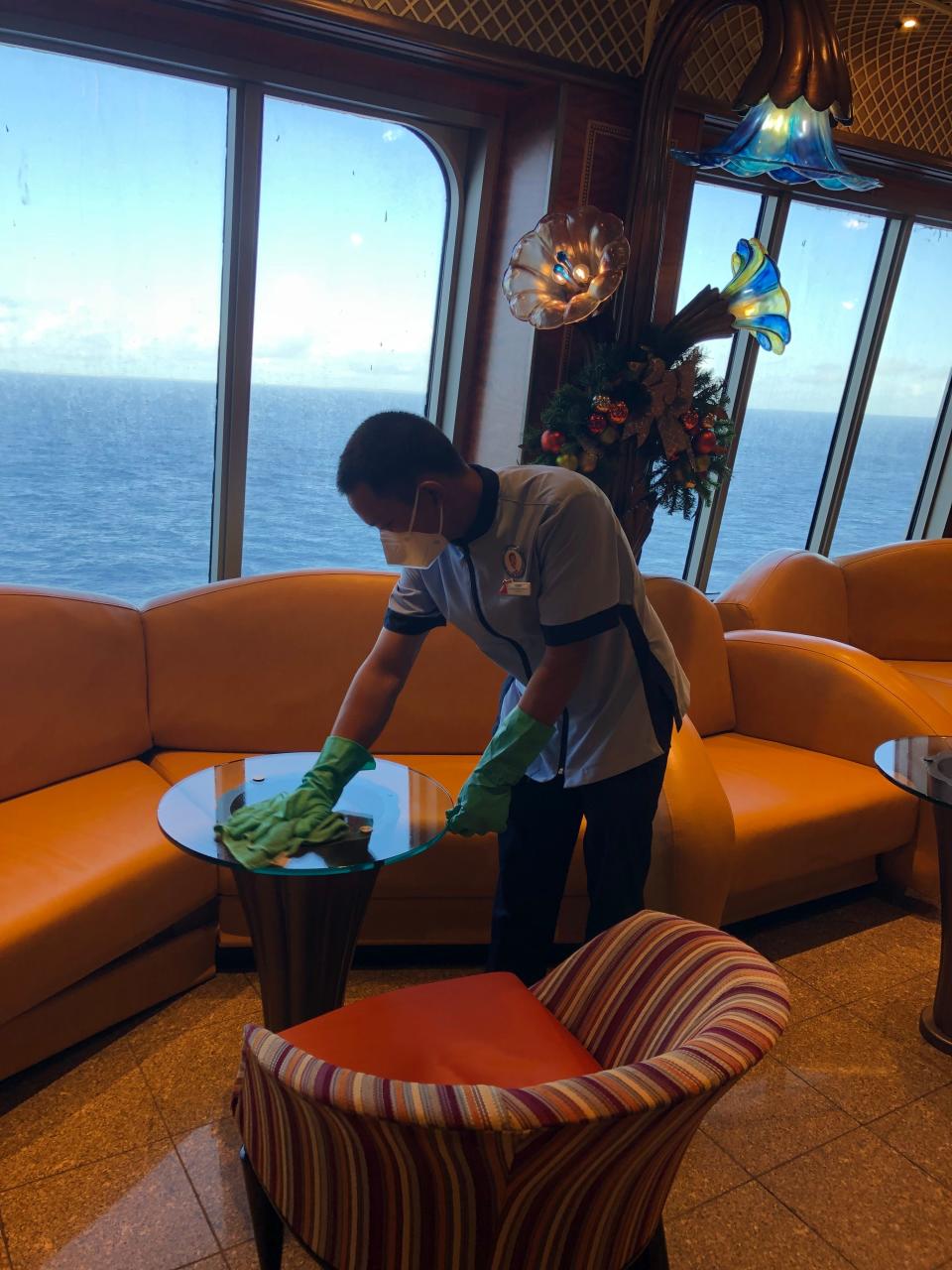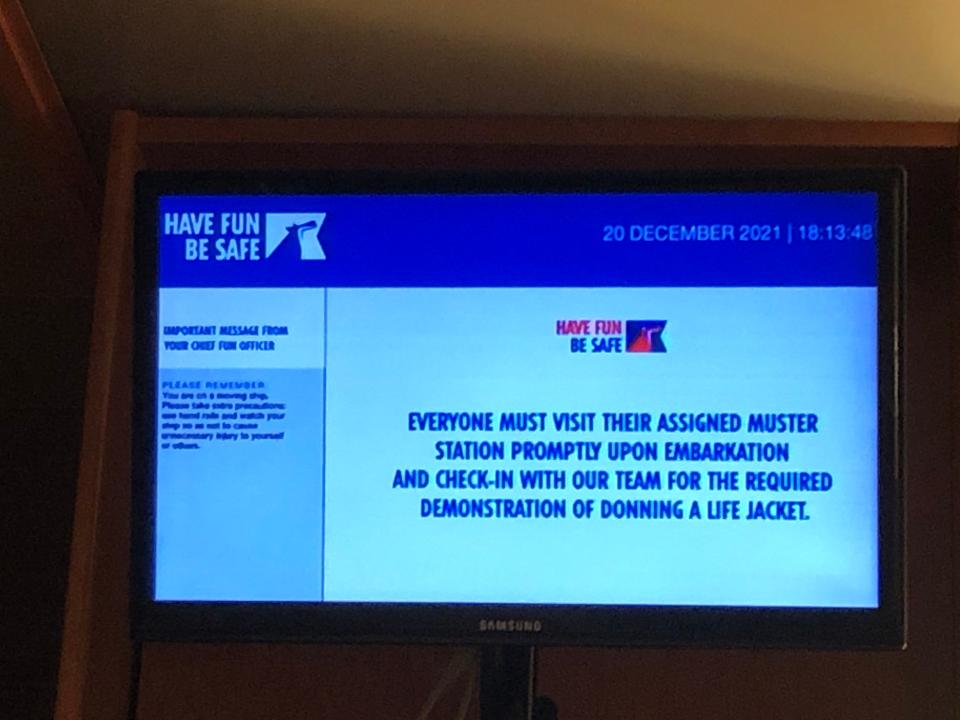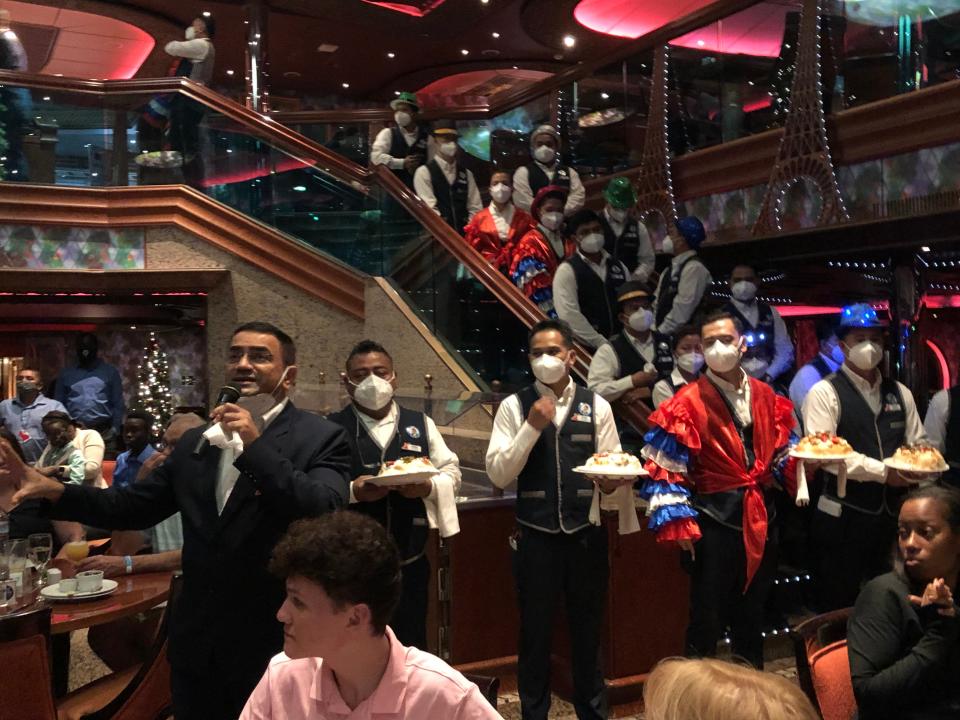After 2 years of COVID-19, the cruise industry is enjoying a spring thaw
Cruise ships are returning to the high seas as pandemic rules are relaxed and more boats return to their regular sailings.
Cruise Lines International Association, the organization that represents more than 90% of global oceangoing cruise lines, reports 88% of its affiliated cruise ships are currently out to sea. Spokeswoman Laziza Lambert said the group expects 100% of its ships to set sail by the end of July, noting that the Centers for Disease Control and Prevention recently rescinded a risk advisory in place for cruising since March 2020.
“Materially, it doesn’t change anything; it was a recommendation,” she said. “But it certainly inspires cruise confidence, and demand for cruising is high.”
The demand comes as cruise lines are beginning to drop limits on the number of passengers on their ships. Carnival Cruises spokeswoman AnneMarie Matthews said the line’s protocols allow flexibility in passenger limits, depending on conditions.
“Many of our ships were full during spring break, and we expect that to continue into the busy summer travel season,” Matthews said.
Longtime cruiser Dr. Cheryl Kovalski, 67, of Northville, said she wasn’t worried about contracting COVID-19 during her 17th Disney cruise in early March.
“They had us wear masks inside, and most people complied with that,” she said of her birthday cruise to Mexico with her husband. “I just wasn’t concerned. I’m vaccinated, I’m boosted. We take all these supplements. And they were sanitizing everything all the time.”
She said that because the Disney ship was only half full, she and her husband weren't put in the position of dining with strangers at mealtimes. On the downside, there was less entertainment than usual aboard the ship.

Kovalski and her husband particularly enjoyed disembarking at Disney’s private island.
“It really was like being on an extension of the ship, so it was fine,” she said, noting that that they skipped going ashore at popular destination Cozumel, which they have visited on past cruises. “We had been there already and we didn’t want to risk anything. If it was our first time, I would have worn a mask and used hand sanitizer.”
Carnival requires masks in indoor public areas of it ships, in the on-board medical center and on any form of transportation, including water shuttles. Passengers must also wear masks when embarking and disembarking. Social distancing is recommended at larger outdoor gatherings. All crew members are masked outside their personal rooms, Matthews said.
Since cruising resumed in July 2020 in Europe, more than 7.5 million passengers have boarded a cruise, Lambert said. By end of 2023, industry experts hope to see that number rise to pre-pandemic levels of 30 million.
As for the threat of the BA.2 omicron subvariant, Matthews said her cruise line is prepared.
“Our dedication to the health and safety of our guests, crew, and the communities we visit is reflected in our Have Fun. Be Safe protocols and procedures, which were developed in consultation with our medical experts,” she said. “They have proven very effective during our restart and are adaptable to the evolving public health situation.”
More: Planning to camp at a Michigan site this summer? State park reservations are going fast.
Buy the insurance!
Editor's note: The outlook for travel is improving, but the situation was a bit different in December, when Free Press special writer Tammy Stables Battaglia and her family set out on a cruise just days before the COVID-19 omicron variant began surging. Here's her account of their experience — and their bumpy trip back to metro Detroit.
With COVID-19 rates relatively low last fall, my wanderlust was off the charts. When I discovered that airfare and a week in a Florida condo would cost upward of $3,500 for four of us, I thought of a friend who had raved about her experience on a fall cruise. Most cruise lines, then and now, were offering super-low rates designed to resuscitate a travel industry devastated by the pandemic.
A search on vacationstogo.com turned up a Dec. 20-24 cruise from Miami to the Bahamas for $86.50 per person. That came to less than $1,400 total with taxes and fees for three inside cabins, plus gratuities — all food included! At that price, I asked our sons whether their girlfriends would like to go, too. When I found flights that worked for just under $1,000 for the six of us, I frantically texted to get everyone on board. The $193 insurance policy through Generali Travel Insurance provided the peace of mind to move forward with the trip.

We felt safe booking with Carnival because of its Have Fun. Be Safe protocols. Passengers had to be vaccinated and tested before boarding a ship. The cruise line also includes a strong warning to passengers: “If a threshold of COVID-19 is detected on board the ship, the voyage will be ended, the ship will return to the port of embarkation and your subsequent travel home may be restricted or delayed.”
On our ship, Carnival’s Conquest, every crew member was masked 24/7. We continually saw crew members wiping down, scrubbing and disinfecting everything from banquet seating and stairway handrails to elevator walls and dining room furniture. Little hand sanitizer stands were as plentiful as sanitizing stations in a hospital hallway.
It was comforting, with 2,723 passengers and 1,119 crew on board the Conquest.
The cruise line also required all passengers age 2 and older wear masks on board, specifically in all enclosed areas and on transportation like ferries or cruise-sponsored excursions.

Still — wouldn't you know it? — COVID-19 rates increased while we were at sea as the omicron variant began surging in the U.S. We got back to Miami free of trouble on our cruise, but our group hit a snag when Spirit Airlines canceled our direct flight home on the morning of Dec. 24 “due to an issue in our operations in the MIA (Miami) airport.” We immediately suspected the cancellation was omicron-related, but I managed to book a flight through Houston on Southwest that got us home by 10 p.m. Christmas Eve.
Our flight difficulties reinforced the most important rule of travel during a pandemic: Buy the travel insurance! And make sure to verify that it covers COVID-related issues. Ours provided that if anyone in our travel party came down or tested positive for COVID-19 and our trip was canceled, we were covered.
I also assumed it would cover us if we got stranded someplace as a result of the pandemic. When our flight was canceled, I called Generali from the cruise port. The company quickly emailed me flight options, but I had already booked through Southwest. The Generali agent then emailed me a claim packet.
I scanned and submitted receipts and filled out the forms online a few weeks after our return (there’s a 90-day deadline to submit a claim), including a screen shot of Spirit’s text of why the flight was canceled. Within a couple of weeks, Generali reimbursed the entire cost of the Southwest flight for the six of us, minus a partial refund we received from Spirit. The insurance also covered the more than $200 we spent at the Houston airport's Buffalo Wild Wings for lunch, plus coffee and snacks we bought during the layover. That alone made the insurance worth it!
This article originally appeared on Detroit Free Press: Cruise industry enjoying a spring thaw after 2 years of COVID-19

